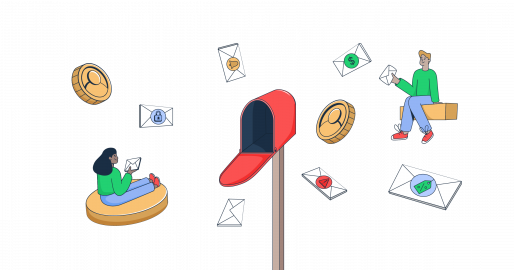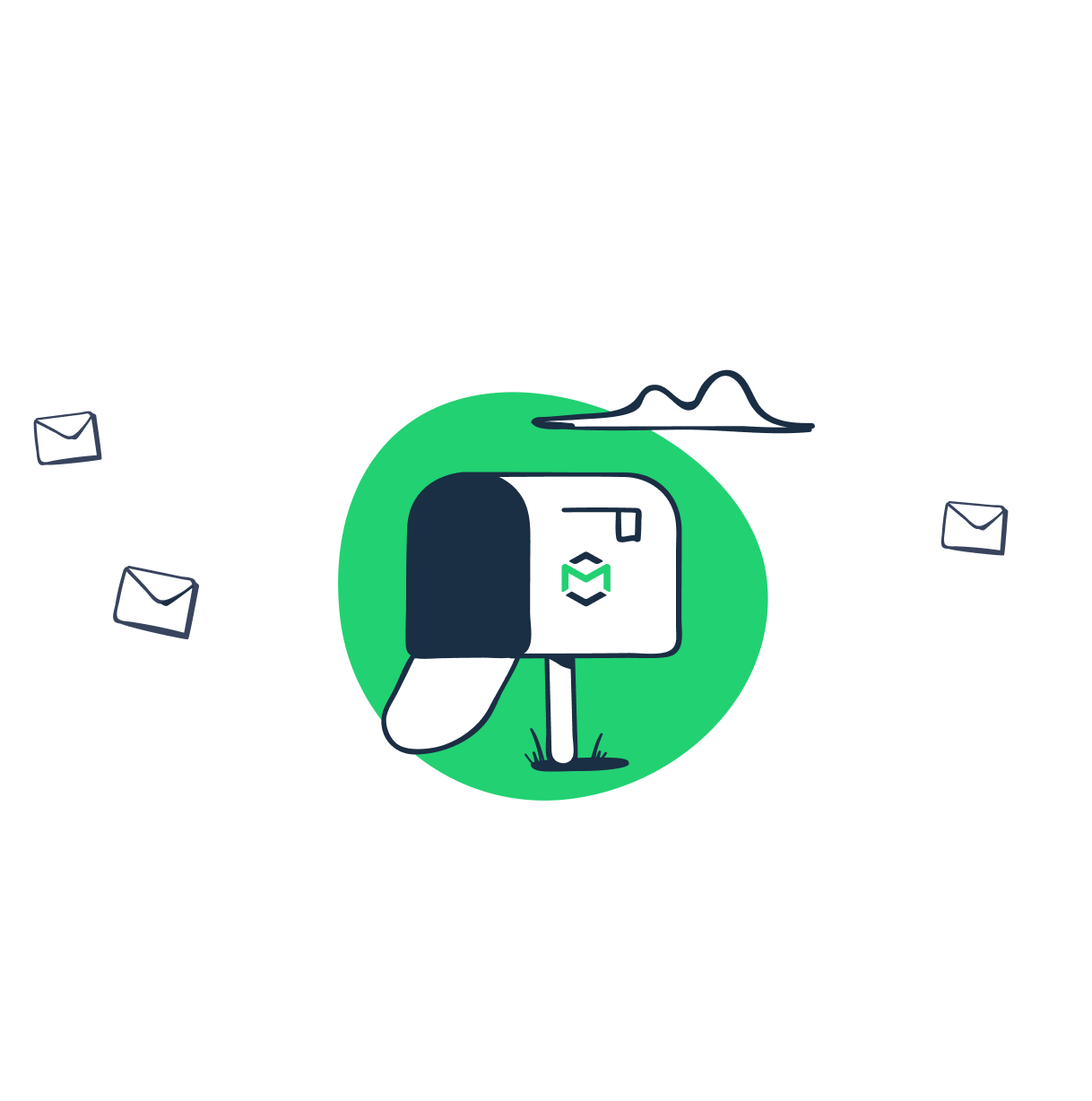When asked how many types of emails exist, Google will give you answers ranging from 10 to 21. ChatGPT counts 30 (you can try Geekflare AI to chat with multiple AI models). If you want to know the exact number, what they are, see real-world examples, and learn best practices for sending them effectively — keep reading.
How many types of emails are there?
There are two main types of emails: transactional emails and marketing emails, which are recognized by most data protection laws and industry regulations.
Transactional emails
These are automated, trigger-based emails sent in response to a user’s action on a website/web app or an automated system event.
However, I wouldn’t use “trigger-based” as the main differentiator for transactional emails, as modern marketing emails can also be action-dependent (more on that later). Instead, the main difference lies in the purpose.
Transactional emails are necessary to deliver essential information, such as order confirmations, account notifications, password resets, and security alerts. This means users need this information to complete an action, access their accounts, track an order, and/or stay informed about important updates.
Transactional emails are typically highly anticipated, resulting in high open rates, as recipients expect them and rely on the information they provide.
Marketing emails
Marketing emails are designed to drive engagement and sales by increasing brand awareness, boosting conversion rates, and nurturing customer relationships. This means that subscribers don’t necessarily need them but might find them valuable or interesting.
Marketing emails can take many forms, from promotional campaigns and special offers to newsletters and personalized recommendations. Since they are often unsolicited or sent in bulk, marketers must focus on the relevance, timing, and personalization of each message to avoid spam filters and maintain engagement.
Most data protection laws require explicit consent to send marketing emails and oblige senders to include a clear and simple opt-out mechanism in every email.
Transactional vs marketing emails
| Criteria | Transactional emails | Marketing emails |
| Purpose | Deliver essential, service-related information | Promote products, services, or brand engagement |
| Consent requirement | Not required under most regulations | Required under most regulations |
| Personalization | Minimal. Often includes user-specific details like order numbers | Highly personalized based on user behavior, preferences, and segmentation |
| Engagement expectation | Highly anticipated by recipients | Can be intrusive if not well-targeted |
| Spam filter risk | Low, as they contain necessary information | Higher risk if poorly targeted or too frequent |
| Primary audience | Existing customers or registered users | Potential and existing customers, subscribers, leads |
| Design format | Usually plain text or simple HTML for clarity and deliverability | Rich HTML designs with images, videos, buttons, and branding elements |
| Examples | Order confirmations, password resets, account notifications, security alerts | Newsletters, promotional offers, new product launch, product updates, re-engagement campaigns |
Depending on the content, intent, and legal interpretation, the same emails can be classified as either transactional or marketing.
This happens because email marketing has evolved, allowing action-triggered emails where even “inactivity”—such as not logging in for a certain period, abandoning a cart, or failing to update billing details — is now considered an “action” that triggers an automated email response.
There are also drip campaigns that typically have a marketing purpose—re-engagement, upselling, onboarding—but are also action-triggered.
Here are some common examples of emails that often blur the line between transactional and marketing:
| Purpose | Example | Can it overlap? | |
| Notification | Provide important updates about account status, security, or service changes | “Your password was changed” “Service outage alert” | Mostly transactional but can include marketing elements (e.g., feature announcements) |
| Informational | Share updates about the company, industry, or product improvements | “We’ve updated our pricing” “New feature available” | Can be transactional (if relevant to the user’s account) or marketing (if used to generate engagement) |
| Reminder | Prompt users about an upcoming action, deadline, or opportunity | “Your subscription is about to expire” “Webinar starts in 24 hours” | Can be transactional (billing-related) or marketing (event invitations) |
| Lifecycle | Sent at key moments in the customer journey to improve retention and engagement | “Welcome to our platform, here’s what you should do next” “Congrats on your first booking!” | Can be purely transactional (booking confirmation) or marketing (upsell after a milestone) |
Even with the ongoing debate, I firmly believe there are only two different types of emails, and the best way to distinguish them is by their intended purpose.
If an email message is purely informative and a subscriber needs it—whether to complete an action or because you’re legally required to send it, then it’s a transactional email.
If the primary email goal is to drive sales and the subscriber doesn’t need the information, then it’s a marketing email.
Administrative emails
GDPR, PECR, CAN-SPAM, CASL, LGPD, and Australia’s Spam Act 2003 also mention a third type: administrative emails.
Administrative emails can be user-triggered, like security alerts, account suspension notices, or mandatory compliance updates. At the same time, they may contain marketing elements, such as announcements about new features, pricing changes, or service improvements.
While some may argue that administrative emails serve a marketing role or are a separate type of email, I view them as transactional because they convey critical information users need to stay informed, secure, or compliant — even if they don’t immediately realize they need it.
Unlike marketing emails, administrative emails are not optional; they ensure users receive updates that impact their access, security, or overall service experience.
For the sake of clarity, in this post, I focus only on transactional and marketing emails—considering administrative emails as a sort of transactional email.
Both transactional and marketing email categories branch into multiple subtypes. Let’s start with transactional emails and explore their key examples.
Types of transactional emails with examples
For an app, platform, or website to function smoothly, users need to receive certain information (via emails) at the right time. To set this up, developers build transactional email functionality within the product and often integrate an external email-sending platform to keep development efficient and cost-effective. This allows the system to send the following types of transactional emails:
Account and profile emails
These emails cover everything related to user access, setup, and management.
Examples: Welcome emails, account activation, email verification, password resets, login alerts, profile updates, account deletion confirmations, change of ownership notifications.
Billing, order, and subscription emails
These are emails on financial transactions and billing updates.
Examples: e-commerce order confirmations, invoices, shipping updates, subscription renewals, free trial expirations, plan upgrade confirmations, payment failure alerts, retailer purchase receipts.
Security notifications
Emails that protect user accounts from unauthorized access or security risks.
Examples: Suspicious login alerts, 2FA codes, data breach notifications.
Service and system notifications
Automated emails about service status, system actions, or background processes.
Examples: API status alerts, maintenance notifications, automated system updates.
Legal and compliance emails
Mandatory emails are sent for privacy policy updates, regulatory notices, or legal changes.
Examples: Terms of service updates, GDPR/CCPA compliance notifications.
User activity notifications
Emails triggered by user actions within a platform.
Examples: Profile updates, subscription plan changes, download confirmations.
Appointment and reservation emails
Confirms or reminds users about bookings, meetings, or reservations.
Examples: Flight ticket confirmation emails, hotel booking emails, appointment reminders.
Support and request emails
Sent when a user submits a support ticket, requests a document, or needs assistance.
Examples: Helpdesk ticket confirmations, requested reports, chat support follow-ups.
Types of marketing emails with examples
Unlike transactional emails, marketing emails are easier to set up thanks to dedicated interfaces found in email service providers (ESPs). These platforms offer drag-and-drop editors, automation tools, and audience segmentation, so users with little to no technical skills can use them.
You still need a custom domain if you want to run professional email marketing campaigns. While some ESPs allow sending without one, using your own domain improves deliverability, branding, and credibility.
Now, let’s break down the main types of marketing emails with examples.
Customer lifecycle emails
These emails welcome new users, nurture leads, and keep existing customers engaged throughout their journey, helping move them through the sales funnel. Depending on the business, they may include welcome sequences, milestone updates, loyalty program details, and personalized recommendations to encourage long-term interaction.
Examples: Welcome emails, milestone progress updates, birthday emails, loyalty program introductions, lead nurturing email sequences.
Promotional emails
These emails highlight special offers, product deals, and limited-time promotions to drive sales and engagement. They may be standalone campaigns or tied to seasonal events and holidays like Black Friday, Christmas, or back-to-school sales.
Examples: Limited-time discounts, coupons, special offer emails, holiday sales, flash deals, early access promotions, seasonal campaigns.
Event invitation emails
These emails aim to encourage recipients to register for an upcoming event, webinar, or conference. Typically, they include key details about the event and the benefits a person would get if they joined.
Examples: Weekly newsletters, product updates, educational content, community highlights, company announcement emails.
Event invitation emails
Such emails aim to encourage recipients to register for an upcoming event, webinar, or conference. Typically, they include key details about the event and the benefits a person would get if they join.
Examples: Webinar invitations, in-person event RSVPs, virtual workshop signups.
Re-engagement emails
Re-engagement emails aim to win back inactive users by reminding them of your product’s value, offering an incentive, or addressing potential reasons for their inactivity.
Examples: “We Miss You” campaigns, cart abandonment emails, dormant account outreach.
Referral and loyalty program emails
These emails reward customers for their engagement and encourage them to bring in new users. Such emails typically include eye-catching images and an exclusive or time-limited offer to create a sense of urgency or exclusivity.
Examples: Referral rewards, VIP program updates, point redemption offers, personal discounts.
Survey and feedback request emails
These emails are used to gather insights from customers through reviews, testimonials, or direct feedback. To increase response rates, they often use personalized messaging, clear calls to action, and incentives like discounts or loyalty points. You can use a survey tool to create and embed surveys directly in your emails, making it easy for customers to provide feedback without leaving their inbox.
Examples: Post-purchase survey emails, product experience feedback, customer satisfaction ratings.
Upsell and cross-sell emails
These emails encourage customers to upgrade their plan, add extra services, or purchase complementary products based on their past behavior or interests.
Examples: Plan upgrade recommendations, “You may also like” product suggestions, bundle deals, add-on promotions.
How to manage sending different types of emails
Managing multiple email types across different providers and channels creates operational complexity that slows development and increases costs.
Courier eliminates this friction by serving as the orchestration layer between your application and any email service provider, whether you’re sending transactional confirmations through SendGrid, marketing campaigns via Mailchimp, or administrative notifications through Amazon SES.
With Courier’s unified API, developers can route different email types to their optimal providers without managing multiple integrations.
Send password resets through Mailtrap’s high-deliverability infrastructure while automatically routing promotional emails to your marketing platform, or seamlessly switch between providers based on performance metrics.
Courier’s visual template designer and drag-and-drop workflow builder let you create sophisticated email sequences that span multiple channels — from email and SMS to push notifications, Slack, and in-app messages — all without writing code.
Beyond email orchestration, Courier Inbox consolidates all message types — transactional confirmations, administrative updates, and marketing communications — into a unified user experience. This means users can access their order updates, security notifications, and promotional offers in one place, while you maintain complete control over message routing and delivery preferences across all channels.
This orchestration approach means faster implementation, reduced vendor lock-in, and the flexibility to optimize each email type for its specific purpose. Instead of building and maintaining separate integrations for every email provider and type, Courier provides one integration that scales with your needs and adapts to your email strategy as it evolves.
Top features:
- Multichannel/Multiprovider Orchestration
- Template management
- Automation builder
- Built-in analytics across channels
Pros:
- Unified approach for all message types
- Reduces development overhead
- Easy integrations across providers
- Robust analytics
- Generous free tier
Best practices for sending emails
To send effective emails, whether marketing or transactional, you need to keep your delivery rate high. This means your emails should actually reach subscribers instead of landing in spam folders or bouncing back.
Deliverability depends on many factors, including infrastructure, technical setup, sending patterns, and content quality. Here’s how to keep everything in place:
- Set up proper authentication – use SPF and DKIM to verify your emails and build trust with email providers. Add DMARC to enforce authentication policies and BIMI to display your brand logo in supported inboxes.
- Maintain a clean email list – regularly remove invalid addresses and inactive subscribers to reduce bounce rates and spam complaints. Use email validation tools to catch typos and detect disposable emails. To keep your email list healthy from the start, use double opt-in to confirm new subscribers. Learn more about email list management in our dedicated guide.
- Send emails at a consistent pace – a well-structured email marketing strategy includes planning campaigns in advance and maintaining a consistent sending schedule. Avoid sudden spikes in sending volume that might trigger spam filters.
- Segment your audience – group email subscribers based on their activity, interests, or purchase history to send relevant emails. A targeted approach improves engagement, reduces unsubscribes, and drives better results. Check out this guide on how to create targeted campaigns step by step.
- Send relevant, personalized, valuable content – tailor your emails to the recipient’s interests, use clear and engaging email subject lines, and avoid spammy language. Include a compelling call to action (CTA) that guides subscribers toward the next step. This way, subscribers will anticipate your emails and interact with them.
- Keep your email design clean and readable – use a balanced layout, consistent branding, and clear formatting to make emails easy to scan. Make sure they work well on mobile, as users often check their inboxes on the go.
- Stay compliant with email regulations – include a clear, easy-to-find unsubscribe link in every email, as required by GDPR, CAN-SPAM, CASL, PECR, and other laws. Get explicit consent before sending marketing emails, process opt-out requests promptly, and only send to recipients who have agreed to receive your marketing emails.
- Track the results – monitor open and click-through rates, as well as bounces, to improve future campaigns. Also, check unsubscribes after each campaign, remove those emails from your list, and analyze the reasons behind them.
- Run A/B testing – experiment with different subject lines, content variations, and send times to optimize engagement. Use data-driven insights to refine your strategy and improve email performance.
- Use a reliable email-sending service – a reliable email provider ensures the best email performance, helping maintain a strong sender reputation and reducing the risk of emails being blocked. Look for a tool with reliable email infrastructure, dedicated or well-managed shared IPs, built-in monitoring to track deliverability metrics, IP warming to gradually build trust with email providers, and analytics to measure performance and engagement.
We recently conducted an independent deliverability test to compare the performance of popular email service providers under identical conditions.
We used free plans, shared IPs, and the same email template for each provider, ensuring consistency.
Through seed testing, we closely monitored how the emails were placed in recipients’ inboxes, whether they ended up in spam, or if they were missing altogether.
Here’s how different ESPs performed:
| SMTP service | Email placement results |
| Mailtrap | Inbox: 78.8% Tabs: 4.8% Spam: 14.4% Missing: 2.0% |
| Amazon SES | Inbox: 77.1% Tabs: 1.9% Spam: 20.0% Missing: 1.0% |
| Mailgun | Inbox: 71.4% Tabs: 3.8% Spam: 23.8% Missing: 1.0% |
| SendGrid | Inbox: 61.0% Tabs: 1.0% Spam: 17.1% Missing: 20.9% |
| Postmark | Inbox:83.3% Tabs: 1.0% Spam: 14.3% Missing: 0.9% |
For a detailed breakdown of the test methodology and full results, check out this analysis.
Mailtrap provides solid email infrastructure, top-tier analytics, and robust testing features, guaranteeing high deliverability while assisting you in refining your sending strategies. It’s the perfect solution for both marketing and transactional emails, giving you the tools you need to build a strong sender reputation and deliver emails straight to your subscribers’ inboxes.
Wrapping up
No matter how many types of emails you plan to send in your marketing strategy, what really matters is your ability to deliver them to customers or subscribers. To gain more confidence in the email-sending process and expand your knowledge, check out the following resources:



